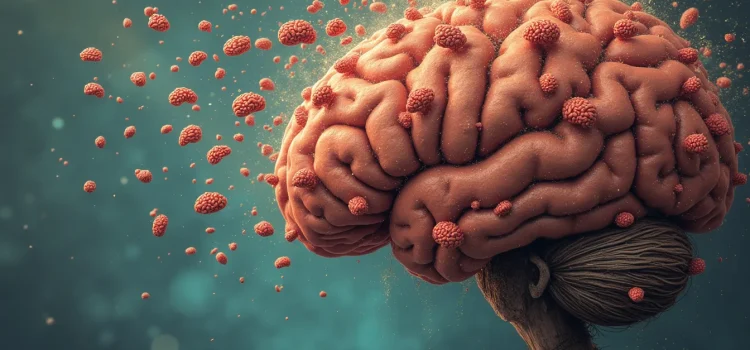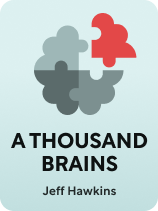

This article is an excerpt from the Shortform book guide to "A Thousand Brains" by Jeff Hawkins. Shortform has the world's best summaries and analyses of books you should be reading.
Like this article? Sign up for a free trial here.
Are your thoughts the result of thousands of tiny brains voting? What if your sense of self is actually an illusion created by these mini-minds?
In A Thousand Brains, Jeff Hawkins presents a groundbreaking theory about how our brains function. He proposes that the neocortex consists of thousands of cortical columns, each acting as a mini-brain. These columns work together to create our complex cognition and awareness.
Read on to learn about the Thousand Brains theory and see how it could revolutionize our understanding of human intelligence.
The Thousand Brains Theory
In essence, Hawkins’s Thousand Brains theory is that the brain is composed of thousands of nearly identical information processing units from which our awareness and intelligence emerge. We’ll begin by describing the functions of these units, how each supports a fraction of the brain’s total function, and how they coordinate with each other.
Hawkins proposes that the neocortex, the part of your brain responsible for higher cognitive functions, consists of around 150,000 cortical columns that each act as a mini-brain. Each column receives inputs, builds mental models, and makes predictions just as the brain does as a whole. The coordinated activity of these thousands of mini-brains working together produces the complex cognition and awareness that your brain is capable of.
(Shortform note: Hawkins attributes the discovery of cortical columns to Vernon Mountcastle in the 1950s, but as recently as 2005, neuroscience research had failed to establish a definitive purpose for these columns. The concept of a “column” itself wasn’t well-defined, with researchers using the term to refer to a variety of vertical cell clusters without a consensus on their significance. Furthermore, the existence and nature of cortical columns across different species is inconsistent, suggesting they may not be a fundamental unit of brain organization.)
According to the Thousand Brains theory, each mini-brain in the neocortex processes a specific aspect of sensory input. One cortical column might learn how an object feels, while another learns what noises it makes. No single column has a complete understanding of any given object or concept. Instead, your brain’s knowledge is distributed across thousands of these columns. This architecture makes the brain robust and resilient—it doesn’t depend on any individual neuron or cortical column to function. Rather, cognition emerges from the parallel, redundant processing of all the mini-brains working together. Your cortical columns are highly interconnected, allowing them to integrate their outputs into a unified whole.
(Shortform note: It’s long been understood that different parts of the brain process different senses, though few authors before Hawkins explain exactly how the brain composites inputs into a sensory “whole.” In Brain Rules, John Medina suggests that there are two steps your brain takes to process your senses. First, your brain first assembles the different types of stimuli you’ve absorbed into a full picture. Second, it interprets this picture by adding meaning. Since the interpreting step is subjective, based on individual experience, no two brains will perceive any given stimulus in the exact same way. Nevertheless, assembly and interpretation require some physical process in the brain for your neurons to carry them out.)
Hawkins posits that each mini-brain communicates its findings to the rest, and through a process akin to voting, the cortical columns arrive at a consensus about what your senses detect and how you should react. Each column announces its perception and preferred reaction based on its individual input, and the brain’s overall response corresponds to the majority opinion of the columns. This produces what your conscious mind perceives as a unified experience despite the distributed nature of cortical processing.
| Your Thousand Brains’ Consensus of Self If your conscious awareness is, as Hawkins suggests, a product of thousands of unconscious mini-minds voting, that may provide a scientific grounding to the belief of some philosophers (and many practicing Buddhists) that your sense of being a unified “self” is just an illusion. In Waking Up, Sam Harris argues that while your consciousness emerges from the workings of your brain, your sense of self—the feeling that you’re an incorporeal being looking out through your eyes and steering your body—is merely a figment of your brain’s imagination. This feeling is a product of what Harris calls “psychological continuity,” the constant creation and narration of memories about your experience from one moment to the next, which leads to the illusion that the “you” inside your head today is the same person you were yesterday or will be tomorrow. If Hawkins is right, then the “you” who’s reading this is simply an amalgamation of an ever-changing voting bloc of unconscious cortical columns living side-by-side in your skull. |
How the Brain Works
To fully understand Hawkins’s ideas about how the human brain generates intelligence, we’ll have to explore how the brain works as a whole. We’ll cover how the brain’s newer structures (those that form what we call the neocortex) relate to its older, more primitive components. We’ll describe the fundamental building blocks of the neocortex, how they create mental models of the world, and how the same neural circuitry that lets us navigate our physical environment also gives us the capacity for abstract thought and contemplation.
In Hawkins’s book, before he delves into his new Thousand Brains theory, he takes a moment to review the older prevailing theory. The old model proposes that your brain processes sensory information, like vision and hearing, in a step-by-step manner like a flowchart. At the bottom of the chart, different nerves in your brain respond to simple features, such as lines and colors. As you move up the hierarchy, each new level of the brain responds to increasingly complex information from the regions below it.
Hawkins argues that, while this theory explains some early neuroscience findings, it treats sensing as a static, one-way process, ignoring how your movements and changing environment actively shape your perception. The “hierarchical” theory also can’t explain how your brain fills in gaps to create a cohesive understanding of the world from partial sensory data. Hawkins writes that, while the hierarchy theory was a good model for brain research to work from, neuroscientists now recognize that it needs updating to incorporate the interactive, dynamic nature of perception.
| Other Views on the Brain The hierarchical theory that Hawkins discusses is far removed from the most highly popularized model of the brain—namely that different cognitive abilities are segregated in the brain’s left and right hemispheres. Commonly known as “brain lateralization,” the left and right brain’s different functions were originally mapped in the 1930s by Canadian surgeon Wilder Penfield. Psychologists have long believed that individuals are more dominant on one side or the other, describing them as “left brain” or “right brain” people. However, more recent MRI studies show that there’s no such thing as left or right dominance. In Seven and a Half Lessons About the Brain, Lisa Feldman Barrett argues that the left/right model is overly simplistic to the point of being misleading. It gives a false impression that specific regions of the brain control specific bodily functions, when in fact each function is controlled by clusters of neurons networked throughout the brain. The neural clusters that Barrett writes about may be equivalent to the “cortical columns” that we’ll see are central to the Thousand Brains theory, but Barrett’s focus is on brain development, not the minutiae of how nerve clusters function. Meanwhile, the hierarchical view of brain structure is alive and well, though the hierarchy that neuroscientists study is more complex than that which Hawkins presents. It isn’t a simple top-down hierarchy like a corporate organizational chart. Instead, different areas of the brain’s sensory systems are arranged based on how close they are to the input. However, scientists have found that the brain has many neural connections that let information skip steps in the process. Proponents of this theory admit that the brain can only be semi-hierarchical—not totally sequential or totally random. The brain’s “hierarchy” ends up being messy and complicated—or, as Hawkins suggests in this book, perhaps there’s not much hierarchy at all. |
The Old Brain and the New
Though the thousands of mini-brains that comprise your neocortex get all the credit for intelligent behavior, they’re far from the only important part of your brain. Instead, the neocortex is entirely dependent on the older, more primitive parts of your brain to interact with the outside environment at all. Here, we’ll expand on how the different parts of your brain interact, what functions the primitive parts of your brain perform, and how the two work together to build your understanding of the world.
Hawkins explains that the human brain is divided into two main parts—the Old Brain and the neocortex. From an evolutionary perspective, the Old Brain is ancient and is similar to that in many animal species. It’s responsible for maintaining your basic biological functions and reflexes. In contrast, the neocortex is a more recent evolutionary development. It’s much larger in humans than in other species, accounting for 70% of your brain and acting as the source of your intelligence. The neocortex processes sensory information and, in humans, is capable of complex cognitive functions such as language and mathematics.
The Old Brain’s Influence
Although your neocortex is where your higher thought processes reside, Hawkins writes that it doesn’t operate in isolation from your Old Brain. All sensory signals and motor commands must pass through the Old Brain before reaching the neocortex or being enacted by the body. Though the neocortex is divided into different regions that process specific types of information, such as vision, hearing, and language, these regions are highly interconnected. Every part of the neocortex is also connected to both the sensory inputs and the motor control areas of the Old Brain, indicating the close relationship between your senses, your thoughts, and your actions.
Hawkins is clear that the brain doesn’t process information in a linear, input-output fashion like a computer. Instead, the neocortex constantly makes predictions based on past experience and the Old Brain’s current sensory input. When predictions and inputs match, your neocortex strengthens its existing neural connections—such as when you judge how hard to toss a ball and it lands exactly on your target. When your neurons’ predictions are wrong, like when you miss when throwing a ball, your brain will form new neural connections to update its mental models of the world. This process of prediction and error correction is a fundamental aspect of how brains learn, and since all the neocortex’s information comes from the Old Brain, they have to work together to enable intelligent thought and decision-making.
Cortical Columns
From the high-level view of the brain, let’s zoom in on the neocortex. In a way, the neocortex looks like a crumpled-up towel, but if you were to flatten it out, you’d see that it’s a single sheet made of layers of nerve cells. Looking even closer at the flattened neocortex, we’ll find that it’s chiefly composed of vertical “columns” of cells that form circuits capable of making predictions and creating models of anything the brain encounters.
According to Hawkins, cortical columns are the fundamental information processing units of the neocortex. Each cortical column—a “mini-brain” in its own right—consists of a vertical arrangement of brain cells (neurons) spanning the horizontal layers of the neocortex. The human brain has approximately 150,000 cortical columns, and despite serving a variety of functions—such as interpreting speech or remembering directions—every cortical column operates according to the same basic principles. This uniformity suggests that the brain processes every type of information using a standard set of rules, making the study of cortical columns crucial for understanding brain function as a whole.
Within a cortical column, neurons receive input through their dendrites—the finger-like extensions on the end of each nerve cell—and synapses—the points at which nerve cells connect. Neurons learn to “predict” certain inputs and react when inputs differ from their expectations. Hawkins explains that when multiple neurons in a cortical column receive the same unexpected input, they “fire” as one, sending signals to other columns throughout the brain. Since each neuron receives inputs from thousands of synapses, a single cortical column can process hundreds of inputs, make predictions, and generate responses at the same time.
Models in the Mind
However many inputs they learn, no single neuron can create what we’d consider a coherent thought. That’s why Hawkins asserts that clusters of neurons with thousands of connections are needed to fully interpret your senses and generate your mind and body’s reactions. Working together, these clusters of neurons create models of your environment, decide what to do and think based on those models, and learn more information about the world when your current models prove insufficient.
Hawkins suggests that, to make accurate predictions, cortical columns model objects and their positions in three-dimensional space using reference frames, which can be thought of like the grid lines on a map. His research shows that to create reference frames, neurons must be connected to both sensory input and motor output—it isn’t enough to see the world; your brain must be able to move through it. Different layers within a cortical column specialize in modeling objects and their positions separately—some neurons learn the shape of an object, while others determine where it exists. This modular setup lets the neocortex efficiently process and integrate information from your whole range of senses at once.
These mental models form the foundation of all higher cognitive functions. Hawkins writes that as you interact with your environment, your neocortex continuously makes predictions based on your current mental models and compares its predictions to your sensory input. When predictions are accurate, they reinforce your existing models and strengthen their underlying neural connections. When predictions are wrong, your brain updates its models to better reflect reality. This constant cycle of prediction, feedback, and adjustment is the basis of learning, and according to the Thousand Brains theory, what’s happening on the brain’s macro level is actually taking place in each cortical column associated with a particular mental model.
Most of the predictions your brain makes are unconscious. Every time you move, such as by shifting your gaze or stepping into a room, your brain predicts what it expects to perceive. If nothing’s unexpected, you don’t notice anything—your cortical columns don’t light up and fire—but any surprises draw your attention and trigger your conscious brain to update its models. Hawkins says that since each cortical column contributes to hundreds of different mental models, they can switch between hundreds of different maps depending on your current sensory context. This flexibility allows your brain to navigate effectively through your ever-changing world.
Abstract Thought
So far, the mental models we’ve discussed all pertain to physical spaces and objects, but how does the neocortex create and process ideas about things that we can’t see, taste, or touch? If Hawkins is correct that all your brain’s higher functions emerge from the models and predictions created by cortical columns, then the neocortex’s models and reference frames must extend beyond representations of the physical world to enable abstract thought. These abstract reference frames must be more complex than those for physical objects while also functioning in much the same terms—those of creating, moving, and adjusting models of ideas in the mind.
Hawkins explains how the same basic circuitry that lets us navigate and interact with the world also underlies our capacity for language, mathematics, imagination, and conceptual reasoning. The key lies in the nature of reference frames. While reference frames for physical objects are three-dimensional, reference frames for abstract concepts have multiple dimensions, each representing a different aspect or degree of the feeling or idea. For example, emotions like happiness and sadness can be thought of as having dimensions such as intensity, duration, and type. Concepts such as human rights can be thought of as having boundaries and limits much like the contours of a physical object.
To explain abstract thought, Hawkins proposes that, when you think about an abstract concept, your neurons fire as if you’re moving through an abstract reference frame, just as they do for models of the physical world. When you recall a memory—such as that of the house you grew up in—you mentally traverse the associated reference frame—in this case, the mental map of your old house—activating the corresponding neurons in the brain. Similarly, when you explore an abstract concept, such as the Thousand Brains theory, your brain constructs a reference frame that maps out its logical connections and arguments. You then navigate this mental map as you reason through the implications of the theory.
This process of building and traversing reference frames lets you understand and manipulate abstract ideas across various domains, from cooking and music to relationships and emotions. As you create new reference frames, they connect to and build upon your existing knowledge, allowing ideas to cross-pollinate, leading to the emergence of your unique, individual patterns of thought. Thus, Hawkins concludes that the neocortex’s ability to construct and navigate multidimensional reference frames is the foundation of human intelligence and abstract reasoning.
Exercise: Reflect on How You Think
The Thousand Brains theory suggests the thoughts you’re having right now are produced by thousands of mini-brains in your neocortex, each of which represents a small portion of your total cognitive abilities. Think about whether you find Hawkins’s theory plausible and what its implications might be.
- What do you find surprising or counterintuitive about how Hawkins describes the brain’s higher functions? In what way does his explanation of the neocortex differ from your previous understanding of the brain?
- Do you find it plausible that the same mental processes we use to navigate the physical world might also govern how we think about abstract concepts? Why or why not? When you think of an abstract idea, how do you “picture it” in your mind?
- If all of human intelligence is produced by a basic neural circuit copied thousands of times in your brain, what does that say about the potential for computer circuits and software to achieve human-like cognition? Do you believe that’s something that might happen in your lifetime, and if so, how do you feel about that?

———End of Preview———
Like what you just read? Read the rest of the world's best book summary and analysis of Jeff Hawkins's "A Thousand Brains" at Shortform.
Here's what you'll find in our full A Thousand Brains summary:
- Why we need updated models for brain research
- How a new theory about human intelligence could be used to advance AI research
- Why human intelligence poses a more immediate threat to the world than AI does






